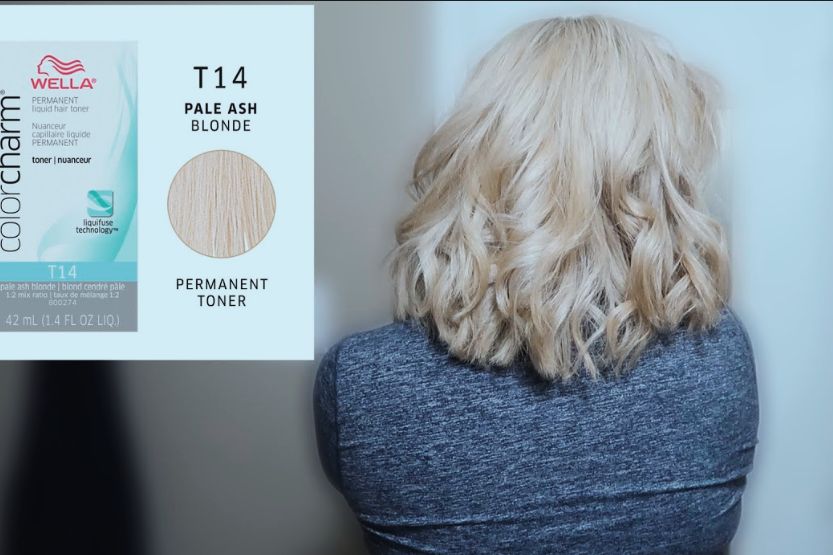Are you having trouble choosing between the Wella T14 and T18? These two hair toners might look the same. Note, though, that the two have significant differences that you will uncover in this Wella T14 vs. T18 comparison.
The Wella T14 and T18 are both ash-blonde toners. However, the Wella T14 has violet-blue tones, making it ideal for removing orange tones in bleached blonde hair. Meanwhile, T18 is the lightest ash blonde tone with a violet base.
Read on to learn more about the differences between the Wella T14 vs. T18
Wella T18 vs. T14

Wella T14 and T18 Are the Most Popular Wella Products
Use the right toner to get the just-right blonde hair color you aimed for from the start. Wella products have always been reliable when it comes to these things. The Wella T14 and T18 are the most popular.
Toners Neutralize Unwanted Tints in the Hair
These are the toners most people use to neutralize unwanted tints in the hair. You can often use these products to create delicate blonde shades, like platinum and beige.
Wella T14 and T18 Look Identical
The T14 and T18 might look identical but use different base colors. If you choose the wrong one, you will get vastly different results from what you expected. It might get so bad that you must re-tone your air to make it look right.
Differ in the Undertones
The Wella T14 is a pale ash blonde toner with violet-blue undertones. This makes it the right choice for bleached blonde hair with some orange tones. The Wella T18, on the other hand, being the lightest ash blond toner, only has a violet base.
The violet neutralizes the yellow tones. However, this will only work if your hair is level 10 (pure yellow) or higher.
Use the Right Toner to Avoid Hair Damage
Not using the right toner will not damage your hair. The problem is that it will be a hassle to do it again. This is why it is important to know the differences between Wella T18 and T14.
What Is Hair Toner and How Does It Work?
As the name suggests, this product tones bleached hair. It does so by neutralizing the brass color that pops up whenever you bleach your hair. This is the “secret” to making bleached blonde hair look natural. It prevents it from looking as if it came out of a bottle.
There have been a lot of people who tried to bleach their hair at home. The problem is that it ended up like someone poured a pail of banana yellow paint on their heads.
A toner is a combination of ammonia and other chemicals. When mixed with the developer, it forms a sort of gel. When you apply this concoction to your hair, it will slightly lift the color off your hair. After that, it will tone it to the shade of blonde you are looking for.
More on Wella T14 and T18
Wella T14
The Wella T14 is a permanent liquid toner for pale ash blonde hair. It helps by neutralizing the orange or gold tones in the hair. As a result, you can have a beautiful ash-blonde color with a bit of silver.
Do you have trouble with brassiness after bleaching your hair? Then this toner’s violet and blue base colors will help you cancel it out.
For this toner to work, you must mix it with a 10- or 20-volume developer. Just follow the instructions on the packaging. It usually states that you should leave the toner and developer in your hair for around 30 minutes.
Wella T18
The Wella T18 is the Lightest Ash Blonde color. It is somewhat similar in color to the T14, but this has a violet base. This violet base can help significantly reduce or completely neutralize the yellowing that usually happens upon bleaching your hair.
Can You Use Both T14 and T18?
Hair Styling Professionals Advise Against Using Both
Wella T14 works best against copper/gold tones, and the T18 works best on yellow. A lot of people, though, wonder if they can use both products at the same time. Technically speaking, mixing both toners to deal with the copper and yellow tones in your hair is possible.
However, many hair styling professionals advise against doing this at home. The difference between Wella T14 and T18 can quickly turn your hair coloring session into a disaster.
Adjust the Toner’s Ratio
If you are sure that you can handle it, be extra careful. Adjust the ratio of toner that you use and still apply the same amount of developer. You should consider how much your bleached hair is orange vs. yellow.
For instance, if most of your hair turns orange, use more T14 than T18, and vice versa. If you think there’s an equal amount of copper and yellow, use half-and-half of T14 and T18.
Apply Each Toner to Certain Parts of Hair
Alternatively, you can apply each toner to the parts where you think they are necessary. For instance, apply T14 only on the parts with more orange hair showing.
T18, on the other hand, is for parts where there is more yellow. However, this can be quite tricky. You will likely have significantly different shades of ash brown in your hair.
Consult with a Hair Care Professional
The level of uncertainty heightens when mixing two colors of toners, especially if you are DIYing it at home. The results can be very unpredictable if your hair has not been lightened appropriately before applying two different toners. You should seriously consult with a hair care professional before
How to Use Wella Toners

If you have chosen a hair color shade, you got through the most difficult parts of the process. You can start using the Wella toners.
Materials
In that case, you will only need the following:
- Your choice of Wella Color Charm Toner (T14 or T18)
- 20-volume color developer
- Nitrile gloves
- Dye brush
- Glass bowl
- Plastic wrap or tinfoil
Instructions
1. Do a Strand Test
Mix toner and developer in a 1:2 proportion. As you mix the two components, it will form a thick gel. Before applying this to your head, you should do a strand test first. That way, you can get a feel of the processing time.
Pick a small section of your hair normally hidden from view. Test the toner and see how much time needs to elapse until your hair reaches your desired results.
2. Apply Toner
Separate your hair into sections with thin layers. Use the brush to apply the toner as even as you can. You can try starting with the hair where it is parted, around the face and neck. You can then work your way towards the center. I find that it is easier to do it this way.
3. Wait
Do not be shocked when the toner suddenly changes into a deep shade of blue or purple. This is completely normal. This is the toner doing its work. Don’t worry.
You will not end up with purple or blue hair. If you want a darker shade of blonde, let the toner sit for half an hour. However, if you want it lighter, rinse it off after just 10 minutes.
4. Shampoo and Condition Your Hair
After achieving your ideal hair color, wash out the toner using your choice of shampoo. Be sure to use conditioner afterward. Do not rinse the conditioner off and leave it in your hair. Let it dry and brush it like you normally would.
Again, what’s the difference between Wella T14 vs. T18? Wella T18 and T14’s colors are different. Wella T18 is Wella’s lightest ash blonde with a violet base, while Wella T14 is a pale ash blonde with violet and blue base.
Is Toner Damaging to Your Hair?
Technically, yes. The toner itself will not harm your hair, but the bleaching process preceding the toning process does. Using a toner will not turn your hair blonde, especially if you are a brunette. Also, the developer you need to mix with the toner does some damage.
Not a lot of people are aware that the developer can potentially damage their hair. Just like bleach, the developer opens the cuticle of the hair. This makes the color from the toner penetrate the strands.
This is why bleaching your hair blonde too often will cause irreparable damage to your hair. Try to limit it as much as possible.
In addition, the strongest developer that you should use is 20-volume. Anything stronger will only damage your hair if you do not know what you are doing. The 30- and 40-volume developers are only for professional use.
Although it might seem fun to change hair colors frequently, give your hair time to recover. Say, for example, you did not like blonde hair as much as you thought. In that case, wait at least a week before you dye it dark again.
Aside from giving your hair a rest, you can also change your mind about the color. The blonde color will still shift a bit after a couple of days, and you might like it by then.
How Do You Fix a Toner Mistake?

Although toning your hair is quite straightforward, there are still a couple of stumbling blocks. All these may make the process more complicated than necessary.
Here are the three most common mistakes that people make when toning their hair:
1. Use a Toner Lighter Than Your Hair’s Current Level
This happens when the person is too worried that they would be making their hair darker than intended. However, using a toner lighter than your current level can create an unbalanced tone. This can produce a weird look on your hair.
The solution is never to use a toner that is at a higher level than what your hair’s been lifted. Trust the color level of the toner.
2. Do Not Go Overboard When Eliminating the Hair’s Warm Gold Tones
This usually happens when you go overboard upon removing all the warm gold tones in your hair. You may think that it will give your hair a magnificent silvery look. However, it will only make your hair lose its brightness. It causes your hair to look dull.
The solution here is not to eliminate all orange or yellow tones. Instead, try to strike a good balance.
3. Do a Couple of Toning Sessions
It is not a good idea to tone your hair to your desired color in one go. Aside from being usually impossible (toner can only do so much per session), it also damages your hair severely.
The solution here is to resign yourself to the truth. You will need to do a couple of sessions before your hair can reach your desired color. It might even take a couple of months to achieve your perfect hair color, so be patient.
4. Do Not Use Blue Toners on Yellow Hair
This usually happens when you use the wrong toner color. In this case, use an ash toner that contains blue base color on heavy yellow hair. Of course, blue and yellow make green.
The solution to this problem is not to use blue toners on yellow hair. What you need to use are purple-tinted toners.
5. Use a Protein Filler to Balance the Color Tones
Using a darker toner without a protein filler will make your hair turn into a muddy gray. This is not even a gray color that looks natural. Your hair will turn a muddy gray.
To prevent this, use a protein filler to balance the color tones after bleaching your hair. After a couple of days, it will be okay for you to start using a toner.
How to Get the Best Possible Toning Results
1. Follow The Package Instructions for Your Color Toner
Never “tweak” the package instructions of your toner. They are there for a reason. It might not seem harmful, but you are handling ammonia, and using it willy-nilly is not recommended.
2. Apply Toner on The Yellowest/Orange-Est Parts
Work on the most discolored parts of your hair before doing the rest of your head. However, before coloring the other parts, wait 10 minutes and check if you are getting the right color. If unsatisfied with the partial results, reapply toner to the area.
3. Don’t Wait Too Long
The package instructions on the Wella T14 and T18 state not to let the toner stand for over 30 minutes. Over-toned hair can be a nightmare to deal with. It is also very difficult to fix. Use a timer to prevent over-toning your hair.
4. Pick the Right Toner
When using the Wella T14 or T18, ensure that your hair is at least level 9 or lighter. If your hair is even a level too dark, you will not even notice any significant improvement.
5. Use 20-Volume Developer
Using a 10-volume developer because you do not want to use strong chemicals on your hair is counter-productive. This will only produce temporary results.
Use a 20-volume developer instead of a 10-volume. By doing that, you have an assurance that the color will not wash out whenever you wash your hair.
6. Pay Attention to Your Natural Hair Color When Choosing a Toner
Considering your natural hair color ensures that every toning session will result significantly. Check the color wheel and pick the color you need to neutralize (orange, yellow, or others).
Take note of the color that is across it, too. For instance, if you want to neutralize yellow, use a toner that has a purple toner.
7. Ask For Help When You Need It
As mentioned earlier, toning your hair is not necessarily a straightforward process. You may run into hair issues that are too much for your skills.
In that case, do not be afraid to seek help from a professional hairdresser. If your hair is not cooperating with you, visit a local hair salon. Ask professionals to help you.
Don’t wait until your hair has severe damage before asking for help. It might be too late if you wait too long.
8. Completely Saturate Every Strand of Your Hair
No one likes to have a patchy-colored head of hair, so take your time when applying the toner. Make sure you have applied enough toner to your hair. If you improperly apply toner, you will get patchwork-colored hair, which is quite difficult to fix.
9. Consider Using a Porosity Equalizer
Bleaching sessions can be quite harsh on your hair. Even one session can leave patches of your hair more porous than the others. A porosity equalizer will even out the porosity of your hair strands. This will make the toner color your hair more evenly.
In Closing – Wella T14 vs. T18
Even though the Wella T14 and T18 look almost identical, they have significant differences. The T14 and T18 are ash-blonde colors, but the Wella T14 has a violet-blue tone, counteracting orange tones. On the other hand, the Wella T18 has a violet base for neutralizing yellow tones.
Bleaching your hair is not the only thing you should do to make your hair blonde. Use a color toner for at least a couple of weeks. That way, you can reach the color that you are striving for.
Read next:

![DHL Vs. FedEx Vs. UPS [What Are the Differences? Which is Better?] DHL Vs FedEx Vs UPS](https://howchimp.com/wp-content/uploads/2021/05/DHL-Vs-FedEx-Vs-UPS-300x200.jpg)
![Avis Vs Budget Car Rental [What Are the Differences? Which is Better?] avis vs budget](https://howchimp.com/wp-content/uploads/2021/07/avis-vs-budget-300x200.jpg)

![Read more about the article Is Dove Shampoo Good for Your Hair? [Dove Review]](https://howchimp.com/wp-content/uploads/2022/05/is-Dove-shampoo-good-for-your-hair-300x200.jpg)
